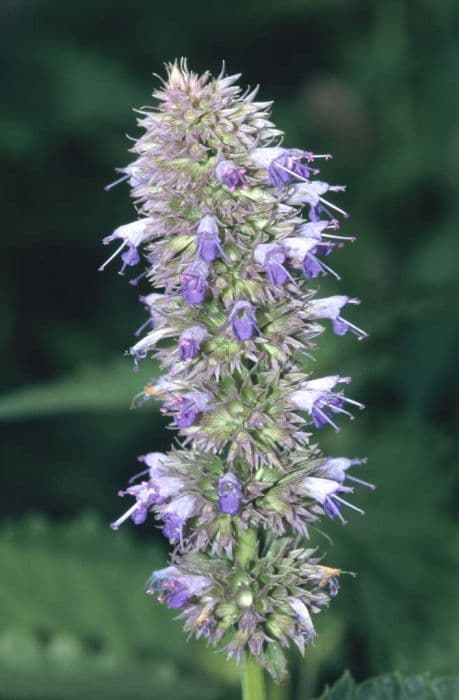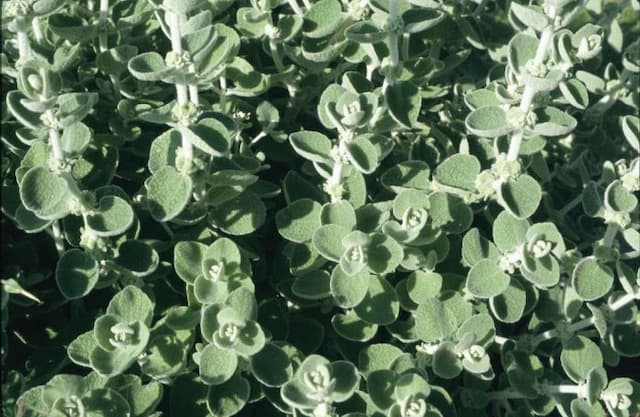English Lavender Lavandula angustifolia 'Hidcote'

ABOUT
Lavandula angustifolia 'Hidcote', commonly known as English lavender, boasts a stunning display of deep purple flowers that emerge from slender, elegant stems. The buds are tightly clustered, forming compact spikes that stand proudly above the foliage. Each individual bloom is small, tubular, and adorned with delicate petals that exude a soothing fragrance known to attract bees and butterflies to the garden. The plant's leaves are narrow and silvery-green, with a soft, velvety texture. They form a lush, grey-green mound that complements the vibrant purple of the blooms. The contrast between the foliage and the flowers creates a captivating visual effect, making English lavender a favorite among gardeners for borders, herb gardens, and as a ground cover. The overall shape of the plant is rounded and bushy, giving it a neat, yet informal appearance. Its stems are woody at the base, becoming more herbaceous and supple as they reach towards the sky. The leaves may sometimes show a slight curve or twist, adding to the plant's charm and character. As the season progresses, the flowers may fade to a softer shade of purple or even a pale lavender, providing a subtle change in the garden's color palette. These enduring blossoms are often used in dried flower arrangements and for their essential oils, making English lavender not only a visual delight but also a useful plant for various aromatic applications. In the landscape, English lavender is celebrated for its low-maintenance nature, drought resistance once established, and its ability to thrive in a variety of soil conditions, as long as they are well-drained.
About this plant
 Names
NamesSynonyms
Hidcote Blue Lavender, Hidcote Lavender, English Lavender.
Common names
Lavandula officinalis, Lavandula vera, Lavandula spica, Lavandula delphinensis, Lavandula angustifolia.
 Toxicity
ToxicityTo humans
Lavender, specifically Lavandula angustifolia 'Hidcote', is generally considered non-toxic to humans. However, like any plant, consumption in large quantities could potentially cause discomfort or an adverse reaction, especially in individuals with plant allergies or sensitivities. The essential oils are concentrated and can be toxic if taken internally in large doses. Symptoms of poisoning from ingestion of large quantities of essential oils might include nausea, vomiting, abdominal pain, and in severe cases, CNS depression. It is always advisable to enjoy lavender for its aroma and in culinary uses where it is used sparingly and not consume it in large amounts.
To pets
Lavender, The most common form of lavender, Lavandula angustifolia 'Hidcote', is generally recognized as safe for pets. Ingesting lavender is unlikely to cause poisoning in pets, although eating it in large amounts may lead to gastrointestinal upset, including vomiting or nausea. The essential oils found in lavender can be more problematic, potentially causing irritation or an allergic reaction if a pet comes into contact with a large quantity of the oil. It is always a good practice to keep a close eye on pets and prevent them from ingesting large amounts of plants.
 Characteristics
CharacteristicsLife cycle
Perennials
Foliage type
Evergreen
Color of leaves
Gray-green
Flower color
Purple
Height
1-2 feet (30-60 cm)
Spread
2-3 feet (60-90 cm)
Plant type
Shrub
Hardiness zones
5
Native area
Mediterranean
Benefits
 General Benefits
General Benefits- Aesthetic Appeal: Lavender 'Hidcote' adds visual interest to gardens with its vibrant purple flowers and silvery-green foliage.
- Fragrance: The plant is well-known for its soothing and pleasant scent, which can permeate a garden space or be used in sachets and potpourris.
- Attracts Pollinators: Lavender 'Hidcote' is popular among bees, butterflies, and other beneficial insects, supporting biodiversity.
- Drought Tolerance: Once established, it is drought-resistant, making it suitable for xeriscaping and low-water gardens.
- Culinary Uses: The flowers can be used in culinary preparations, such as flavored syrups, baked goods, and teas.
- Landscape Versatility: It can be used in various landscape designs, including borders, rock gardens, and as a ground cover.
- Deer and Rabbit Resistance: Lavender 'Hidcote' is generally resistant to browsing by deer and rabbits, reducing the need for protective measures.
 Medical Properties
Medical Properties- Analgesic: Lavender may help reduce pain when used in aromatherapy or applied to the skin.
- Anxiolytic: The scent of lavender is known for its calming effect and can help in reducing anxiety and stress.
- Antispasmodic: It may help to relieve muscle spasms and cramps when used externally.
- Antibacterial: Lavender has been shown to have antibacterial properties and can be applied to minor wounds to prevent infection.
- Anti-inflammatory: The plant is sometimes used in topical treatments for its potential anti-inflammatory effects.
- Sedative: The essential oil of lavender is widely used in aromatherapy for its sedative and sleep-inducing properties.
- Antiseptic: It can be used for its antiseptic properties in minor cuts and burns to reduce the risk of infection.
- Carminative: Lavender may help in reducing flatulence and stomach discomfort when used in herbal teas.
 Air-purifying Qualities
Air-purifying QualitiesThis plant is not specifically known for air purifying qualities.
 Other Uses
Other Uses- Natural moth repellent: Lavender sachets can be placed in closets or drawers to ward off moths and protect clothing without the use of chemicals.
- Fresh scent for linens: Dried lavender can be used in linen cabinets to impart a fresh, herbal scent to bed sheets and towels.
- Flavor enhancer in cooking: Culinary-grade lavender adds a unique flavor to baked goods, such as scones, cookies, or infused sugars.
- Homemade soap ingredient: Lavender buds and essential oil are often used in soap-making for their pleasing scent and natural colorant properties.
- Natural dye: The flowers of lavender can be used to dye fabrics and yarns a soft purple hue using traditional dyeing methods.
- Eco-friendly confetti: Dried lavender buds can serve as a biodegradable alternative to traditional confetti at weddings and celebrations.
- Craft projects: Lavender stems and buds can be incorporated into wreaths, floral arrangements, or potpourri mixes for decoration.
- Soothing eye pillows: Filled with lavender buds, eye pillows can be used for relaxation during meditation or before sleep.
- Lavender wands: The stems of lavender can be woven into wands or bottles that, when crushed, release their fragrance.
- Natural ant repellent: Sprinkling lavender around windows and doorways can help to deter ants from entering the home.
Interesting Facts
 Feng Shui
Feng ShuiLavender is used in Feng Shui to bring a calming and purifying energy to a home. Placing lavender in the bedroom promotes restful sleep and relaxation, while in the living space, it can clear the air of negative energy and encourage a peaceful atmosphere.
 Zodiac Sign Compitability
Zodiac Sign CompitabilityLavender is not used in astrology practice.
 Plant Symbolism
Plant Symbolism- Calmness: Lavender is often associated with tranquility and relaxation, partly because of its calming scent that is widely used in aromatherapy and relaxation techniques.
- Purity: The delicate and clean fragrance of lavender represents purity and cleanliness, making it a common choice for soaps, cleansers, and fresheners.
- Silence: This plant can symbolize silence, possibly due to its association with calm and peaceful settings where one can enjoy quietude.
- Devotion: Lavender sometimes symbolizes devotion, as it is a hardy plant that requires care and attention to flourish, much like the dedication required to maintain a devoted relationship.
- Grace: With its elegant stems and beautiful hues, lavender is often associated with grace and elegance.
- Healing: Historically, lavender has been used for its medicinal properties, so it can also represent healing and recovery.
 Water
WaterEnglish Lavender (Lavandula angustifolia 'Hidcote') prefers to be watered deeply but infrequently, allowing the soil to dry out between waterings to mimic its native Mediterranean habitat. Generally, it should be watered once or twice a week during the growing season, depending on the climate and weather conditions, reducing to every two to three weeks in the winter. A good rule of thumb is to provide about one gallon of water per plant for each watering session. Overwatering can lead to root rot, so ensuring proper drainage is key. During hot, dry spells, you may need to water more frequently to prevent stress.
 Light
LightEnglish Lavender thrives in full sunlight and should be placed in a position where it receives at least six to eight hours of direct sunlight daily. The ideal spot for the plant is in a south-facing location where it gets ample sun exposure. Partial shade can be tolerated, especially in the hottest regions, but flowering and fragrance may be reduced.
 Temperature
TemperatureEnglish Lavender is hardy in a range of temperatures, being able to withstand winter cold down to about 10 to 20 degrees Fahrenheit, and summer heat up to 90 degrees Fahrenheit or higher. The ideal growing temperatures for English Lavender are between 60 and 70 degrees Fahrenheit. It's important to provide good air circulation to avoid problems with humidity and cold damp conditions.
 Pruning
PruningEnglish Lavender should be pruned to maintain shape, encourage blooming, and prevent woodiness. Prune the plant in the spring after the last frost and again in early fall, cutting back about a third of the plant's size. The best time for pruning is after the first flush of flowers begin to fade. Regular pruning helps to promote vigorous growth and extend the life of the lavender plant.
 Cleaning
CleaningAs needed
 Soil
SoilLavender prefers well-drained soil with a pH range of 6.5 to 8.0. A mix of 1/3 coarse sand or perlite and 2/3 compost or organic matter is ideal to ensure proper drainage and fertility.
 Repotting
RepottingLavender, known commonly as English Lavender, typically requires repotting every 1 to 3 years to refresh the soil and accommodate root growth. Younger plants may need annual repotting, while established ones can be repotted less frequently.
 Humidity & Misting
Humidity & MistingEnglish Lavender thrives in low to moderate humidity conditions. It is well-suited to dry air, making it ideal for the typical indoor environment, and does not require high humidity levels.
 Suitable locations
Suitable locationsIndoor
Provide bright light, well-drained soil, and modest watering.
Outdoor
Plant in full sun, well-draining soil; water sparingly.
Hardiness zone
5-9 USDA
 Life cycle
Life cycleLavender 'Hidcote', once established from seed or cuttings, begins its life cycle with the germination or rooting phase where initial roots and shoots develop. These quickly grow into young vegetative plants with characteristic narrow leaves and a compact form. As the plant matures, it enters a robust vegetative stage, during which foliage becomes denser and the woody stem develops. The flowering stage follows, typically in late spring to early summer, when 'Hidcote' displays numerous spikes of deep purple flowers that attract pollinators. After blooming, seed formation begins, although many gardeners choose to deadhead the plant to encourage further blooming and prevent self-seeding. Over the years, the plant will enter a maintenance phase, during which time it may require pruning to maintain shape and promote vigorous growth, eventually leading to a decline phase as the plant ages.
 Propogation
PropogationPropogation time
Spring-Summer
The most popular method for propagating Lavender (Lavandula angustifolia 'Hidcote') is by taking semi-ripe cuttings. This is typically done in the summer, from June through August. To propagate, choose a healthy, non-flowered shoot and cut a 3 to 4 inch (approximately 7.5 to 10 cm) length, just below a node. Remove the lower leaves and dip the cut end into a rooting hormone to encourage root growth. Place the cutting in a pot filled with a mix of peat and perlite or horticultural sand. Ensure the environment is warm, with high humidity, but well-ventilated to prevent rotting. Cover with a plastic bag or place in a propagator and in a few weeks, the cutting should root and can eventually be transplanted to a permanent location.









